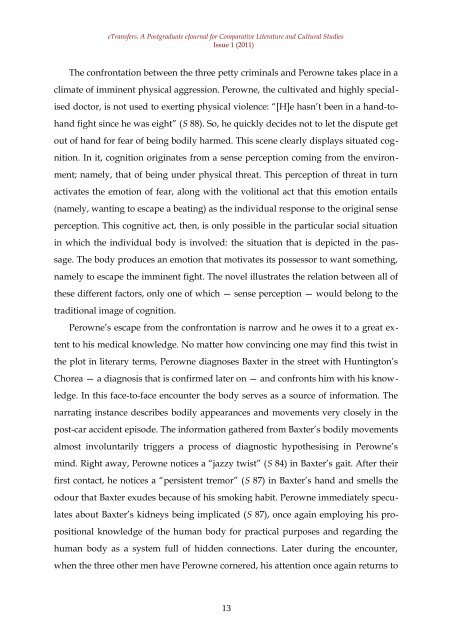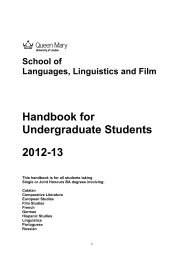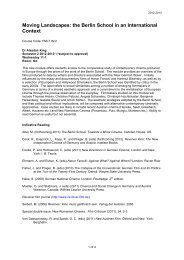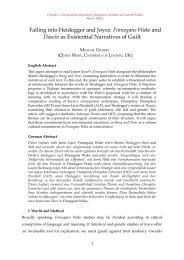You also want an ePaper? Increase the reach of your titles
YUMPU automatically turns print PDFs into web optimized ePapers that Google loves.
eTransfers. A Postgraduate eJournal for Comparative Literature and Cultural Studies<br />
Issue 1 (2011)<br />
The confrontation between the three petty criminals and Perowne takes place in a<br />
climate of imminent physical aggression. Perowne, the cultivated and highly special-<br />
ised doctor, is not used to exerting physical violence: “[H]e hasn’t been in a hand-to-<br />
hand fight since he was eight” (S 88). So, he quickly decides not to let the dispute get<br />
out of hand for fear of being bodily harmed. This scene clearly displays situated cog-<br />
nition. In it, cognition originates from a sense perception coming from the environ-<br />
ment; namely, that of being under physical threat. This perception of threat in turn<br />
activates the emotion of fear, along with the volitional act that this emotion entails<br />
(namely, wanting to escape a beating) as the individual response to the original sense<br />
perception. This cognitive act, then, is only possible in the particular social situation<br />
in which the individual body is involved: the situation that is depicted in the pas-<br />
sage. The body produces an emotion that motivates its possessor to want something,<br />
namely to escape the imminent fight. The novel illustrates the relation between all of<br />
these different factors, only one of which — sense perception — would belong to the<br />
traditional image of cognition.<br />
Perowne’s escape from the confrontation is narrow and he owes it to a great ex-<br />
tent to his medical knowledge. No matter how convincing one may find this twist in<br />
the plot in literary terms, Perowne diagnoses Baxter in the street with Huntington’s<br />
Chorea — a diagnosis that is confirmed later on — and confronts him with his know-<br />
ledge. In this face-to-face encounter the body serves as a source of information. The<br />
narrating instance describes bodily appearances and movements very closely in the<br />
post-car accident episode. The information gathered from Baxter’s bodily movements<br />
almost involuntarily triggers a process of diagnostic hypothesising in Perowne’s<br />
mind. Right away, Perowne notices a “jazzy twist” (S 84) in Baxter’s gait. After their<br />
first contact, he notices a “persistent tremor” (S 87) in Baxter’s hand and smells the<br />
odour that Baxter exudes because of his smoking habit. Perowne immediately specu-<br />
lates about Baxter’s kidneys being implicated (S 87), once again employing his pro-<br />
positional knowledge of the human body for practical purposes and regarding the<br />
human body as a system full of hidden connections. Later during the encounter,<br />
when the three other men have Perowne cornered, his attention once again returns to<br />
13







